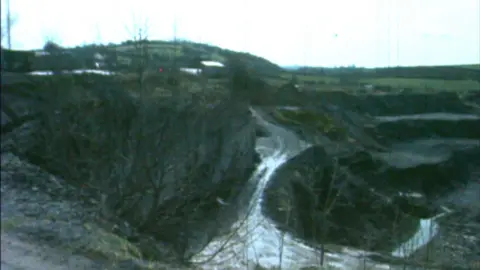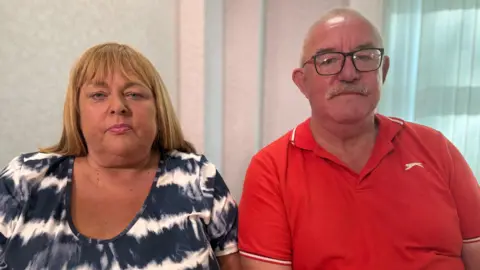Watchdog finds 'numerous failings' in 50-year-old murder investigation
 Beattie family
Beattie familyNorthern Ireland's policing watchdog has identified "numerous failings" into how the murder of a woman was investigated 50 years ago.
Marian Beattie, 18, from Portadown, County Armagh, was last seen leaving a charity dance in Aughnacloy, County Tyrone, on 30 March 1973.
She was observed leaving the premises with a young man just after 01:00 but five hours later her partially-clothed body was found at the bottom of a quarry between Aughnacloy and Ballygawley.
No-one has ever been charged in connection with her death, which police described at the time as a "vicious and cruel murder, with sadistic overtones".

Ms Beattie's family had referred the case to the Police Ombudsman's office after they had raised concerns about the police's investigation.
The ombudsman's office has recommended an independent review should be carried out into the murder of Ms Beattie.
In a report published on Thursday, it found that police had failed to ensure that all lines of enquiry were progressed; that all suspects were interviewed; that all alibis were checked; and that discrepancies between some suspects' accounts and other evidence were examined.
Reacting to the report, PSNI Deputy Chief Constable Bobby Singleton said Marian Beattie was an "innocent 18-year-old".
The PSNI is "committed to helping the Beattie family get answers to their questions and ensure the case is properly investigated," he said.
"Our thoughts are with Marian's family today and we recognise the suffering they have experienced over the years in their quest to have someone brought to justice for her murder."
What happened to Marian Beattie?
In late March 1973, Ms Beattie went to a charity dance at Hadden's Garage on the outskirts of Aughnacloy with her best friend and brother.
During the night she was seen dancing with a young man who she later left with.
Marian's body was found in the early hours of the following day at the bottom of the nearby quarry, and the police opened a murder investigation.
Last month, the PSNI said it was reviewing the murder and appealed to anyone with fresh information to come forward.
Ms Beattie's brother, Gerard Beattie, previously told BBC News NI that his family had never recovered from her murder.

Speaking on Thursday, Mr Beattie said the family was "more than pleased" with the ombudsman's report.
He said the report was "unbelievable", adding: "At least we're moving forward instead of going back."
Colette Toman, Ms Beattie's cousin, said the report "justifies what we said all along in that there were significant failings in this investigation, and there continued to be those failings within the PSNI when they started to contact us again back to 2012, 2013".
She said the family is "very keen to get the chief constable to contact us as quickly as possible to begin this independent review".
The family wants to look into a "new inquest into Marian's death", Ms Toman said.
"Marian's initial inquest was an absolute joke," she said.
Investigation 'undermined by systemic failings'
Police Ombudsman chief executive Hugh Hume said that in the 50-plus years since the murder, "there were only eight documented contacts between the police and the family".
"It is understandable that they have lost confidence and trust in the police."
Family members had told Police Ombudsman investigators that police had made comments on four separate occasions that led them to believe there were potential links between suspects and either police or paramilitaries.
There were no police records of this being discussed, but the Ombudsman report said available information suggests it is more likely than not that such comments had been made.
The Police Ombudsman investigation found that three suspects had paramilitary links and two were former police officers, but was unable to establish whether or not these connections had any impact upon the police investigation.
"Although our enquiries found no evidence of individual police criminality, nor misconduct by any serving officer, the police investigation of Marian's murder has been undermined by organisational and systemic failings," Mr Hume added.
 PSNI
PSNIThe ombudsman investigation found that Northern Ireland's police force at the time, the Royal Ulster Constabulary (RUC), reacted quickly following the discovery of Ms Beattie's body, dispatching Criminal Investigation Department (CID) officers and a Scenes of Crime officer.
Items were recovered, including articles of clothing and forensic samples. These were submitted for analysis to the forensic science laboratory and returned to the police on 18 January 1974.
There is no record of what happened to them after their return to police and all are now missing, the ombudsman said.
They include a palm print, formed in mud on the heel of Ms Beattie's right shoe, which became a significant focus for police. Although a photograph of the print does still exist, the shoe is missing.
During the initial investigation a large number of palm prints were obtained to compare against the print on Ms Beattie's shoe. No match was found.
However, Mr Hume said that although palm prints formed a central aspect of police enquiries, this was problematic for a number of reasons.
These included the poor quality of the muddy print found on Ms Beattie's shoe. Mr Hume said it was clear from the evidence that enquiries relating to this print "would not be capable of providing a positive identification".
He said ombudsman investigators had also found no evidence that police had:
- Conducted any interviews with a number of suspects
- Checked a number of suspect alibis
- Made enquiries about the whereabouts of some suspects on the night of the murder
- Examined discrepancies between the accounts of some suspects and other evidence
- Undertaken any intelligence work in relation to suspects
- Shown a photograph of Marian to witnesses during their initial enquiries, or asked whether they had seen her leaving the dance hall
Police were found to have made only limited use of identification procedures in a bid to establish the identity of the male seen leaving the dance with her.
All physical exhibits recovered during the initial police investigation are also missing, and Mr Hume said this had had "a serious" impact on police investigations.
"If these exhibits had been available, it may have been possible to have conducted further forensic testing using current forensic capabilities, and it is possible that this may have resulted in the identification of the person responsible for Marian's murder," he said.
The Police Ombudsman's investigation acknowledged, however, that efforts were made by police in the mid-2000s to locate the missing exhibits, consisting of searches at Dungannon, Omagh and Aughnacloy police stations, which were ultimately unsuccessful.
Mr Hume added that although Ms Beattie was murdered in 1973, there were lessons to be learned from the case of relevance to current policing.
DCC Singleton said the PSNI "will now take time to consider the recommendations of the Police Ombudsman report and we hope the family will engage with the Police Service as part of that process".
